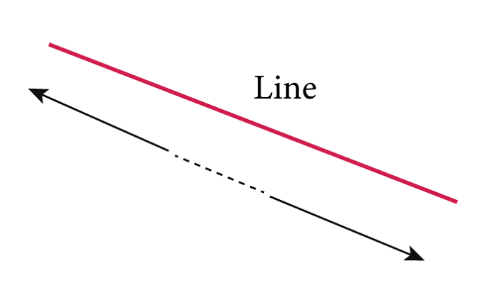Line DefinitionA line is a mathematical concept that represents a continuous set of points that extend infinitely in two opposite directions. In other words, a line has no beginning or end point and is of infinite length. A line can be represented graphically as a straight path on a surface or in space. 
About lineLines are often used in geometric and architectural drawings, as well as in engineering and physics to represent things like paths of movement or the edges of objects. They can also be used in art and design to create visual elements such as lines of symmetry or perspective. In mathematics, lines are often represented using equations. For example, in two-dimensional space, a line can be represented by the equation y = mx + b, where m is the slope of the line and b is the y-intercept. In three-dimensional space, a line can be represented by the equation x = a + bt, y = c + dt, z = e + ft, where a, b, c, d, e, and f are the coordinates of the line. One of the most important properties of a line is that it is the shortest distance between two points. This property is known as the "principle of least action" and is used in physics and engineering to determine the most efficient path for an object to move from one point to another. Types of linesLines can also be classified into different types based on their properties. For example, a line is said to be parallel if it never intersects another line, and it is said to be perpendicular if it forms a right angle with another line. A line can also be classified as horizontal or vertical depending on its orientation. Line segmentAnother important concept in line geometry is the concept of line segments and rays. A line segment is a section of a line that has two endpoints, while a ray is a line that has one endpoint and extends infinitely in one direction. In addition, the concept of angle is closely related to lines. An angle is formed when two lines meet at a common point, and the measure of an angle is determined by the amount of rotation required to align one of the lines with the other. Application of lightLines are also fundamental in the study of geometric transformations such as rotation, translation, and reflection. These transformations can be applied to lines to change their position, orientation, or shape. In addition, lines play a crucial role in the study of conic sections, which are geometric shapes formed by the intersection of a plane and a cone. Conic sections include circles, ellipses, parabolas, and hyperbolas, and they are used in a wide range of fields, including physics, engineering, and astronomy. Finally, lines are an important concept in the study of projective geometry, which is a branch of mathematics that studies geometric transformations that preserve the incidence and cross-ratio of lines. Projective geometry is used in a wide range of fields, including computer graphics, computer vision, and robotics. ConclusionIn conclusion, a line is a mathematical concept that represents a continuous set of points that extend infinitely in two opposite directions. It has many important properties and can be represented in many different ways, such as graphically, using equations, or as different types of lines. This concept is essential in many fields like geometry, physics, engineering, art, and design. In addition to its properties and representations, lines also play a crucial role in various mathematical concepts and theorems. The concept of collinearity states that if three or more points are on the same line, they are said to be collinear. The concept of concurrent lines, on the other hand, states that if three or more lines intersect at a single point, they are said to be concurrent. Another important concept related to lines is the concept of slope. The slope of a line is a measure of its steepness, and it is defined as the ratio of the change in the y-coordinate to the change in the x-coordinate of any two points on the line. Slope is an important concept in physics and engineering, as it helps to determine the rate of change of a given variable. In conclusion, lines are a fundamental concept in mathematics with many applications and properties. They play a crucial role in geometry, physics, engineering, and other fields. Understanding the properties and representations of lines and how they relate to other mathematical concepts is essential for further studies in mathematics and related fields.
Next TopicMotivation Definition
|
 For Videos Join Our Youtube Channel: Join Now
For Videos Join Our Youtube Channel: Join Now
Feedback
- Send your Feedback to [email protected]
Help Others, Please Share










